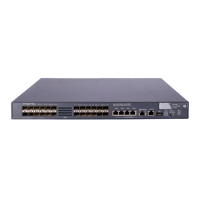
Do you have a question about the HP Enterprise HPE 5820 Switch Series and is the answer not in the manual?
| Layer | Layer 3 |
|---|---|
| Switching Capacity | Varies by model |
| Forwarding Rate | Varies by model |
| Power Supply | Varies by model |
| Weight | 5.5 kg (12.13 lb) |
| AC Input Voltage | 100-240 VAC |
| Operating Temperature | 0°C to 45°C (32°F to 113°F) |
| Product Series | HPE 5820 |
| Port Types | 10 Gigabit Ethernet |
| Management | CLI, Web, SNMP |
| Dimensions | 440 x 360 x 44 mm (17.32 x 14.17 x 1.73 in) |
| Routing protocol | OSPF, BGP, RIP, IS-IS |
| Form factor | Rack-mountable |
| Operating Humidity | 10% to 90% (noncondensing) |
| Dimensions (W x D x H) | 440 x 360 x 44 mm (17.32 x 14.17 x 1.73 in) |
| Jumbo Frames | 9216 bytes |
IRF offers simplified topology, easy management, redundancy, link aggregation, and scalability.
IRF split occurs when an IRF fabric breaks up into two or more IRF fabrics due to IRF link failures.
Master election is held each time the IRF fabric topology changes.
LACP MAD requires IRF members to have links forming a dynamic link aggregation group.
BFD MAD can work with or without intermediate devices.
ARP MAD detects multi-active collisions by using extended gratuitous ARP packets.
This section describes the restrictions and configuration guidelines you must follow.
All IRF member switches must run the same system software image version.
Consider hardware compatibility, fabric size, master switch, physical ports, IDs, priority, topology and cabling.
Assign unique IRF member IDs and priorities to switches before forming the fabric.
Connect and bind physical ports to IRF ports for establishing IRF links.
Includes domain ID, member description, load sharing, MAC persistence, and software auto-update.